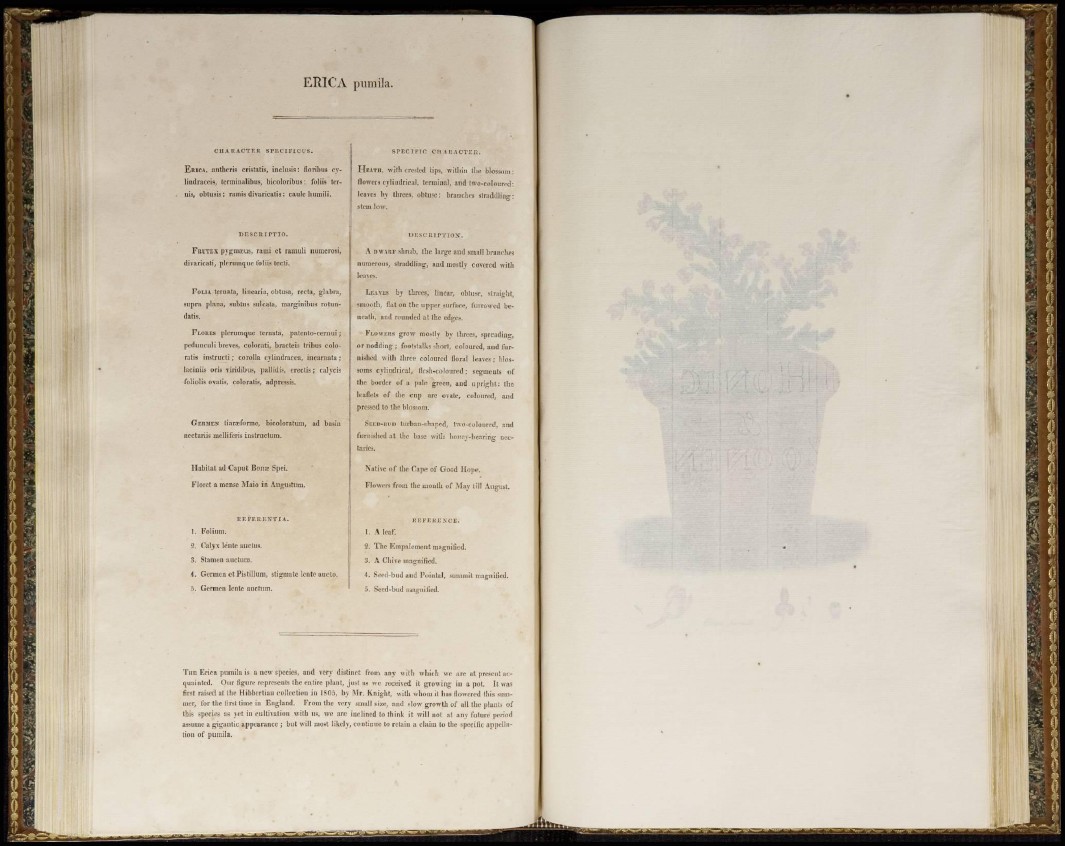
ERICA pumila.
CHARACTER SPECIFIC US.
ERICA, antheris cristatis, inclusis: floribus cylindraceis,
terminalibus, bicoloribus: foliis terms,
obtusis: ramis divaricatis: caule humili.
DESCRIPTIO.
FRUTEX pygmams, rami et ramuli numerosi,
divaricati, plerumque foliis tecti.
FOLIA ternata, linearia, obtusa, recta, glabra,
supra plana, subtus sulcata, marginibus rotundatis.
FLORES plcrumque ternata, patento-cernui;
pedunculi breves, colorati, bracteis tribus colorutis
instruct!; corolla cylindracea, incarnata ;
laciniis oris viridibus, pallidis, erectis; calycis
foliolis ovatis, coloratis, adpressis.
GERMEN tiara?forme, bicoloratum, ad basin
nectariis mellifcris instructum.
Habitat ad Caput Bona; Spei.
Floret a mense Maio in Augustum.
REFERENTIA.
1. Folium.
2 . Calyx lente auctus.
3. Stamen auctum.
4. Germen ct Pistillum, stigmate lente aucto.
">. Germen lente auctum.
S P E C I F I C C H A R A C T E R .
HEATH, with crested lips, within the blossom:
flowers cylindrical, terminal, and two-coloured:
leaves by threes, obtuse: branches straddling:
stem low.
DESCRIPTION.
A nw\RF shrub, the large and small branches
numerous, straddling, and mostly covered with
leaves.
LEAVES by threes, linear, obtuse, straight,
smooth, flat on the upper surface, furrowed beneath,
and r undi •: at the edges.
FLOWERS grow moslly by threes, spreading,
or nodding; footstalks short, coloured, and furnished
with three coloured floral leaves; blossoms
cylindrical, flesh-coloured; segments of
the border of a pale green, and upright: the
leaflets of the cup are ovate, coloured, and
pressed to the blossom.
SEED-BOD turban-shaped, two-coloured, and
furnished at the base with honey-hearing nectaries.
Native of the Cape of Good Hope.
Flowers from the month of May till August.
R E F E R E N C E .
1. A leaf.
2. The Einpnlemeut magnified.
3. A Chive magnified.
4. Seed-bud and Puiulal, summit magnified.
5. Seed-bud magnified.
THE Erica pumila is a new species, and very distinct from any with which we are at present acquainted.
Our figure represents the entire plant, just as we received it growing in a pot. It was
first raised at the Hibbertian collection in 1S05, by Mr. Knight, with whom it has flowered this summer,
for the first time in England. From the very small size, and slow growth of all the plants of
this species as yet in cultivation with us, we arc inclined to think it will not at any future period
assume a gigantic appearance; but will most likely, continue to retain a claim to the specific appellation
of pumila.